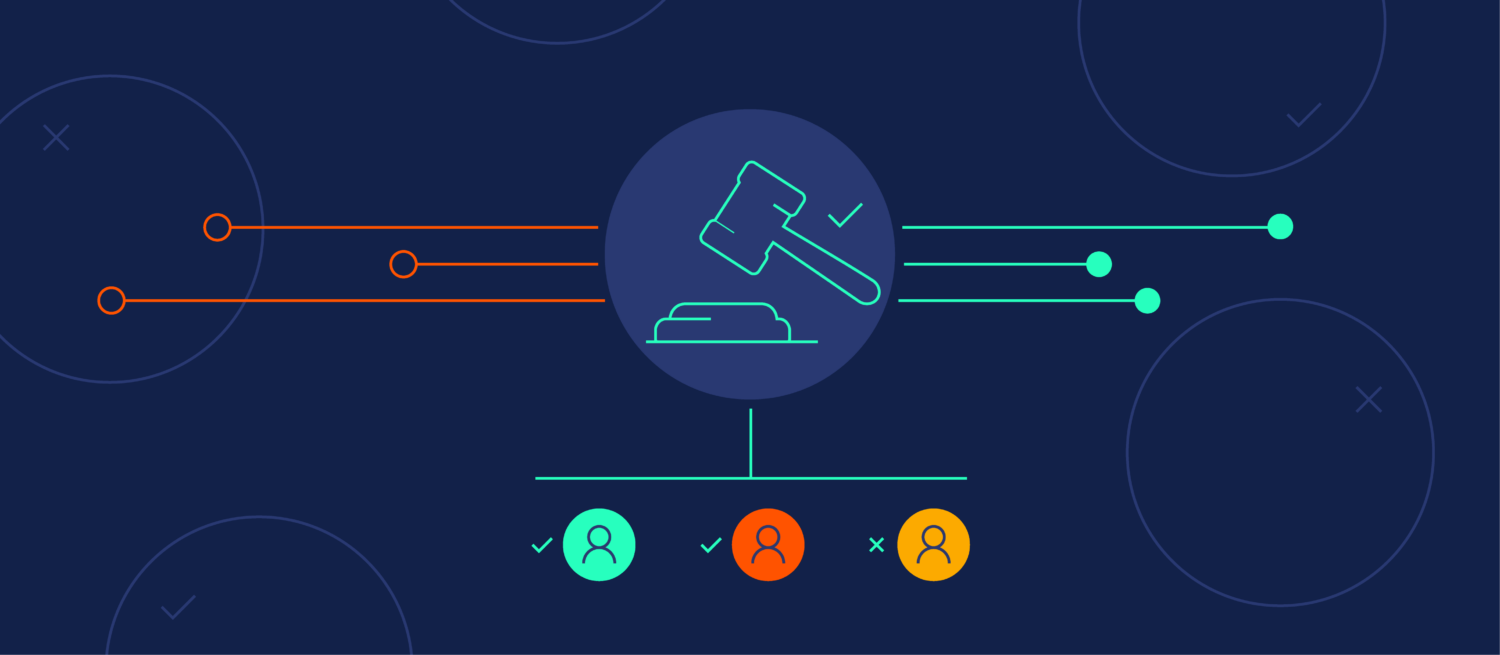This blog is a preview of our State of Web3 Report. Sign up here to download your copy!
Decentralized autonomous organizations (DAOs) are a staple of web3. Internet-native and blockchain-based, DAOs are intended to provide a new, democratized management structure for businesses, projects, and communities, in which any member can vote on organizational decisions just by buying into the project.
At a high level, this is how DAOs work:
- DAO founders create a new cryptocurrency, known as a governance token;
- They distribute these tokens to users, backers, and other stakeholders;
- Each token corresponds to a set amount of voting power within the organization and a price on the secondary market, where it can be bought and sold at will.
While this process is often described as a way to decentralize power, governance token data suggests that DAO ownership is highly concentrated.
The concentration of governance token holdings
By analyzing the distribution of ten major DAOs’ governance tokens, we find that, across several major DAOs, less than 1% of all holders have 90% of the voting power.
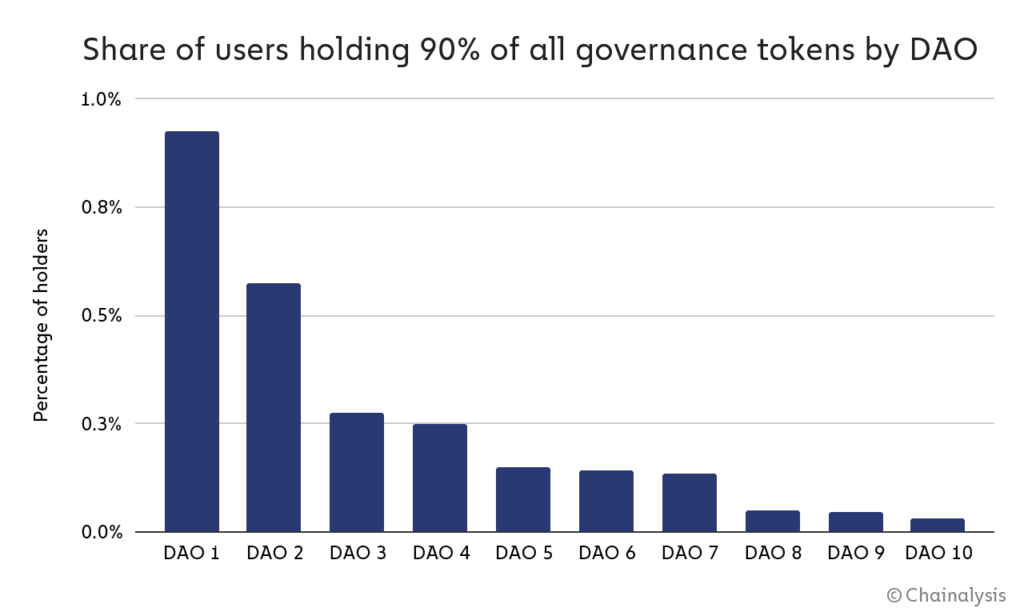
This has meaningful implications for DAO governance. For example, if just a fraction of the top 1% of holders coordinated, they could theoretically outvote the remaining 99% on any decision. This has obvious practical implications and, in terms of investor sentiment, likely affects whether small holders feel that they can meaningfully contribute to the proposal process.
The impact of high concentration on DAO governance
For a governance token holder, there are three key governance actions. Voting is simple – any holder can do it. But what about creating a proposal? And what about passing it?
Per these ten DAOs proposal requirements, we find that:
- A user must hold between 0.1% and 1% of the outstanding token supply to create a proposal.
- A user must hold between 1% and 4% to pass it.
Using these ranges as our lower and upper bounds, respectively, we find that between 1 in 1,000 and 1 in 10,000 of the holders within these ten DAOs have enough tokens to create a proposal.
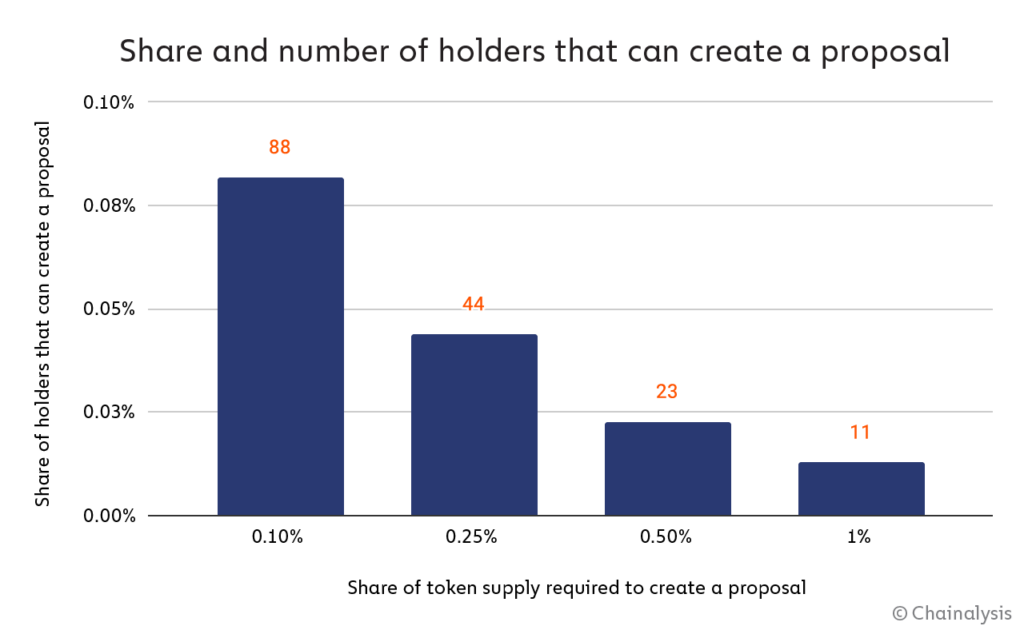
There are several tradeoffs at play here. If too many holders can create a proposal, the average proposal’s quality may fall, and the DAO may be inundated with governance spam. But if too few can, the community may conclude that “decentralized governance” claims ring false.
When it comes to single-handedly passing a proposal, between 1 in 10,000 and 1 in 30,000 token holders have enough tokens to do so.
Overly concentrated voting power in DAOs can result in decision-making that seems to contradict the tenets of decentralization on which web3 is built. For instance, in June 2022, the DAO governing the Solana-based lending protocol Solend faced a problem: Solana’s price was dropping, and if it fell much further, the protocol’s biggest whale user would face a margin call that could render Solend insolvent and send roughly $20 million worth of Solana onto the market, potentially tanking the asset’s price and upending Solana’s ecosystem. The DAO called a vote to take control of the whale’s account and liquidate its position through OTC desks, rather than the open market.
Governance proposal SLND1 has passed.
Special margin requirements for accounts that represent over 20% of borrows are now in effect.
There will be a grace period for 3oSE…uRbE to reduce their leverage by themselves. pic.twitter.com/dsZhFRC8ZX
— Solend (we’re hiring!) (@solendprotocol) June 19, 2022
The proposal passed easily, with over 1.1 million “yes” votes to 30,000 “no” votes. However, more than 1 million of those votes came from a single user with enormous governance token holdings. Without their vote, the motion wouldn’t have passed the 1% participation rate necessary for quorum.
The decision triggered a backlash from the cryptocurrency community, with many questioning how a platform could claim to be decentralized and then take control of a user’s funds against their will. Following this, the Solend DAO voted again to invalidate the proposal, and the whale user eventually began to unwind their position. While the crisis was averted in this case, it raises questions about the ability of a DAO to act in the best interest of all participants when some voters control such an outsized share of governance tokens.
How do DAOs govern, exactly?
Actual governance processes vary enough from DAO to DAO that this question is best answered with examples. Let’s start with the biggest one: Uniswap.
Example: Uniswap Governance
Uniswap is a decentralized exchange (DEX), and, like many DeFi protocols, it is governed by a DAO.
Anyone who holds Uniswap’s governance token, UNI, is a member of this DAO. They can participate in governance by delegating their voting rights to their own or another’s address, by publicizing their opinions, or by submitting their own proposal. The contents of these proposals vary widely: holders have recently voted on whether to finance a grant program, whether to integrate a new blockchain, and whether to reduce the governance proposal submission threshold.
But before someone can submit a proper proposal, their idea must pass the first two phases: temperature checks and consensus checks.
- The temperature check determines whether there is sufficient community will to change the status quo. At the end of the two days, a majority vote with a 25,000 UNI yes-vote threshold wins.
- The consensus check establishes formal discussion around a potential proposal. At the end of five days, a majority vote with a 50,000 UNI yes-vote threshold wins.
If both checks pass, an official governance proposal can be put to a vote. Then, there’s a seven-day deliberation period to discuss the merits of this proposal on governance forums. If at the end of this period there are at least 40 million yes-votes with no-votes as a minority, the proposal has passed, and will be enacted after a two-day timelock.
Example: Dream DAO Governance
Not all DAOs function like Uniswap, but most at least run on similar infrastructure, using voting systems like Snapshot and chat servers like Discord. Dream DAO is no exception, though its mission and therefore its governance process is necessarily unique.
Dream DAO is an impact-oriented DAO created by 501(c)(3) charity Civics Unplugged and designed to provide diverse Gen Zers globally with the training, funding, and community they need to use web3 to improve humanity. Their governance process is run by holders of SkywalkerZ – NFTs that function as both governance tokens and fundraising incentives for anyone interested in donating to the program. For every SkywalkerZ NFT purchased by a donor, a new SkywalkerZ is reserved for a future Gen Zer to join as a voting member, thereby receiving power in the DAO without needing to pay. The purchaser of the NFT can apply to join the DAO and become a voting member as well, or they can leave it to the Gen Z student they’ve sponsored — either way, the NFT is theirs to keep.
By removing financial barriers from the process of participating in DAO governance, Dream DAO empowers its target audience – future Gen Z leaders – to influence decision-making, immerse themselves in web3, and leverage blockchain technologies positively.
Where are DAOs most common and well-funded?
DAOs span the entire length of web3. They govern:
- DeFi protocols like Uniswap ($UNI) and Sushi ($SUSHI).
- Social clubs like Friends With Benefits ($FWB) and Bored Ape Yacht Club ($APE).
- Grant-makers like Gitcoin ($GTC) and Seed Club ($CLUB).
- Play-to-earn gaming guilds like Good Games Guild ($GGG) and Yield Guild Games ($YGG).
- NFT generators like Nouns (1 NFT = 1 vote).
- Venture funds like MetaCartel and Orange DAO.
- Charities like Big Green DAO and DreamDAO (1 SkywalkerZ = 1 vote).
- Virtual worlds like Decentraland ($MANA) and Sandbox ($SAND) .
- And more.
But in terms of raw numbers and treasury sizes, DeFi-related DAOs have a giant lead. The DeFi category accounts for 83% of all DAO treasury value held and 33% of all of the DAOs by count.
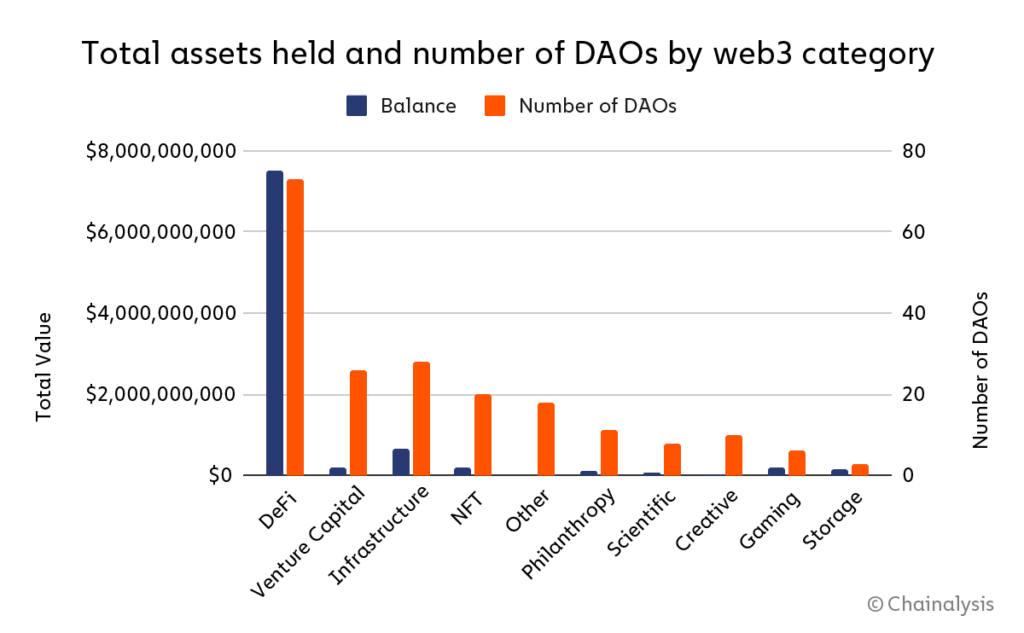
There are also a large number of DAOs focused on venture capital, infrastructure, and NFTs, suggesting that DAOs are appealing to investors, developers, and artists. Their on-chain treasuries, however, are relatively tiny.
To be fair, the lines between these categories are blurry. Gaming DAOs often engage with NFTs, venture DAOs often provide funding to DeFi, and infrastructure DAOs support all of the above categories.
Treasury management: What assets do DAOs hold?
Even though DAOs vary in type and size, most of their on-chain treasuries hold similar cryptocurrencies. The most commonly held cryptocurrency is the stablecoin USD Coin (USDC), with over half of the 197 DAOs we analyzed holding a balance of USDC.
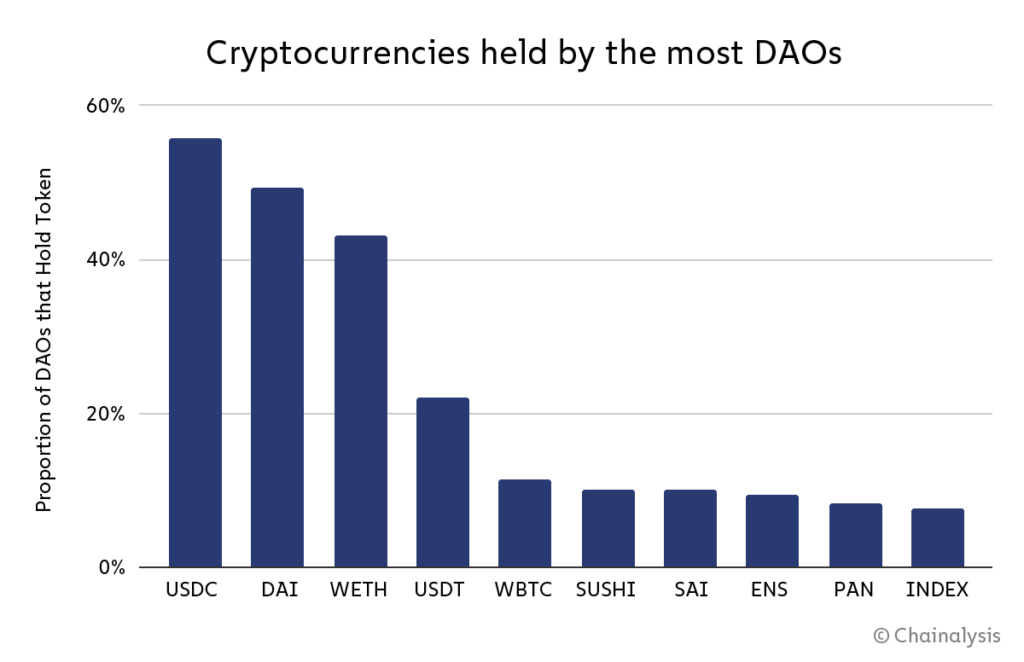
However, stablecoins seldom account for a majority of an on-chain treasury’s value. On average, 85% of DAOs’ on-chain treasuries are stored in a single asset, and that asset is a stablecoin in only 23% of the DAOs we studied.
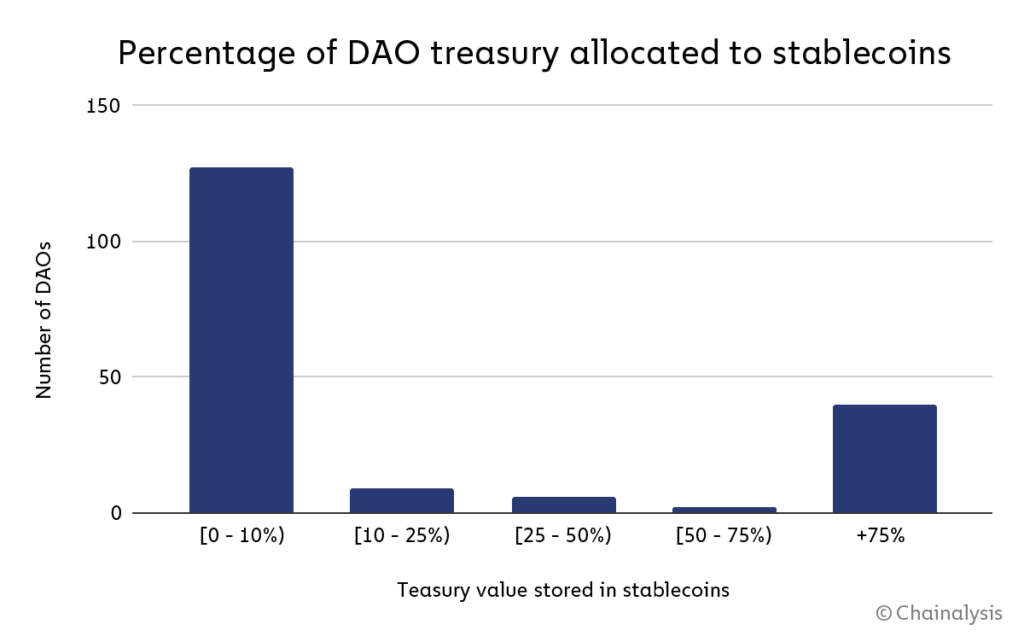
These on-chain treasuries are roughly as volatile as Bitcoin. By assuming DAOs’ current holdings are their historical portfolios over the past year, we find that:
- The average DAO with assets over $1 million has an annualized volatility of 82%, versus 69% for Bitcoin.
- The average DAO with assets over $1 million suffered a maximum drawdown of 51% over the past year, compared to Bitcoin’s drawdown of 72%.
DAO treasury values are also fairly correlated with Bitcoin price movements. 38% of on-chain DAO treasuries have correlations with Bitcoin that are between 0.5 and 1.00.
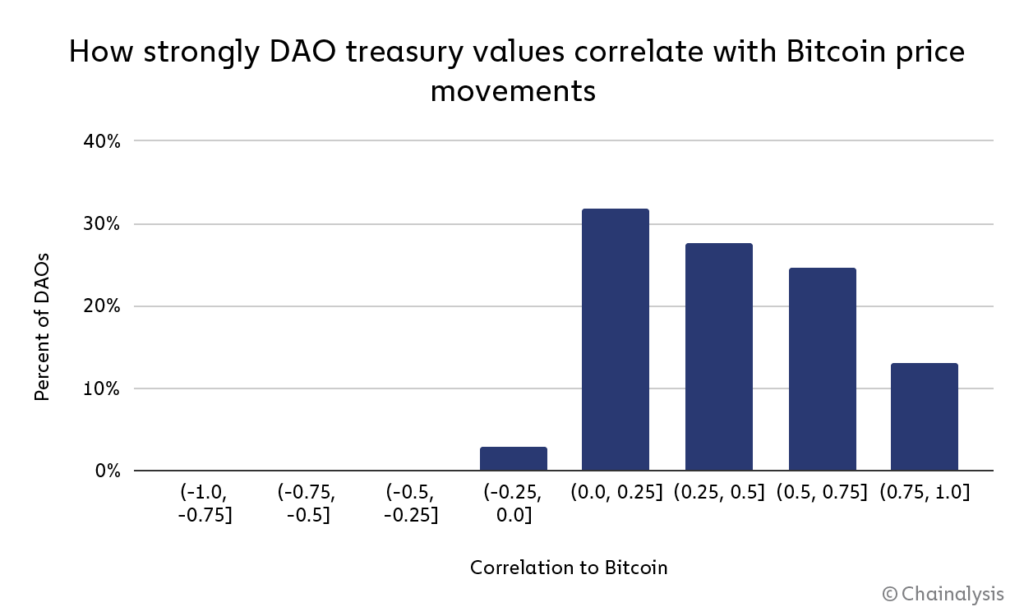
One of the most interesting areas of DAO treasury management that has yet to take off is in mergers and acquisitions (M&A). M&A makes sense for DAOs because it allows them to get into adjacent areas without having to develop internal tooling. As the DAO model matures, we suspect M&A will become more commonplace.
DAOs thus far have also been fairly limited in terms of the types of instruments they use and hold. For example, few DAOs to date have used loans or credit, perhaps due to their uncertain legal status. As DAOs mature, we are likely to see more standardized regulations, management strategies, and reporting practices.
Who contributes to DAOs?
While we don’t collect demographic data about DAO participants, we can learn some things about DAO contributors using blockchain data.
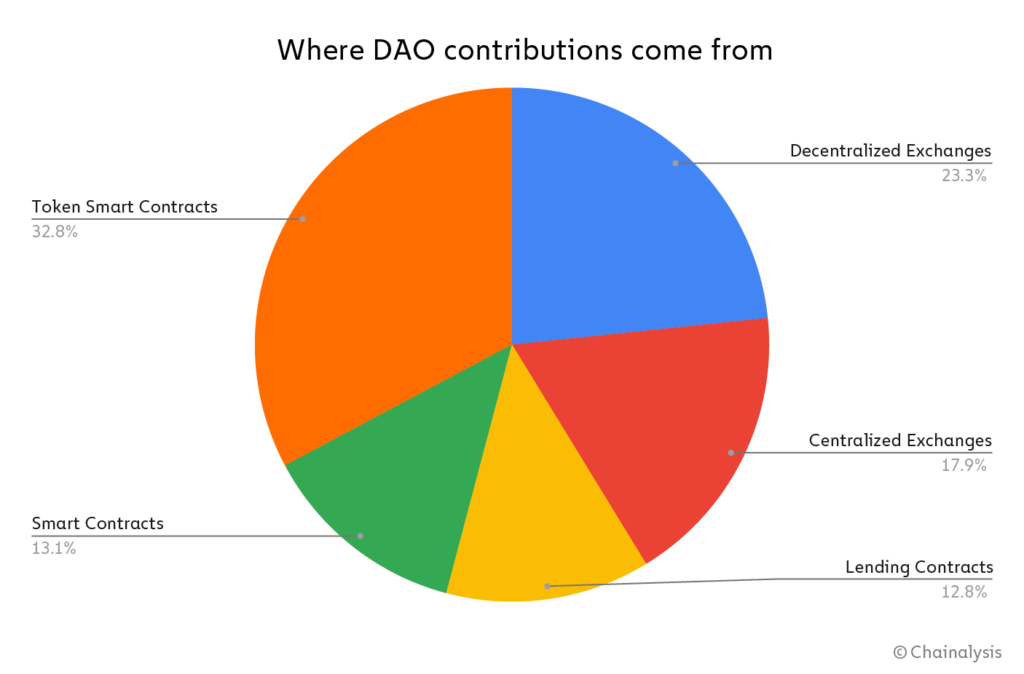
As one might expect, DAO participants are advanced users of cryptocurrency services. Only 17.9% of DAO treasury funds came from centralized services, while the remaining 82.1% originated at decentralized services. This suggests that most DAO contributors also engage with DeFi platforms and likely self-host their cryptocurrency.
The future of DAOs
As DAOs gain momentum, a cottage industry of tooling services and advocacy groups have emerged to help them grow and govern. Superdao streamlines DAO creation; Snapshot simplifies governance; and Coin Center advocates for the industry on Capitol Hill. As they continue to expand, it will be interesting to see what they can accomplish, what they will become, and to what extent they will achieve their goal to decentralize the ownership of the internet. With the proliferation of DAOs today, we’ll have plenty of chances to see.
Download the State of Web3 Report
This website contains links to third-party sites that are not under the control of Chainalysis, Inc. or its affiliates (collectively “Chainalysis”). Access to such information does not imply association with, endorsement of, approval of, or recommendation by Chainalysis of the site or its operators, and Chainalysis is not responsible for the products, services, or other content hosted therein.
Chainalysis does not guarantee or warrant the accuracy, completeness, timeliness, suitability or validity of the information in this report and will not be responsible for any claim attributable to errors, omissions, or other inaccuracies of any part of such material.
